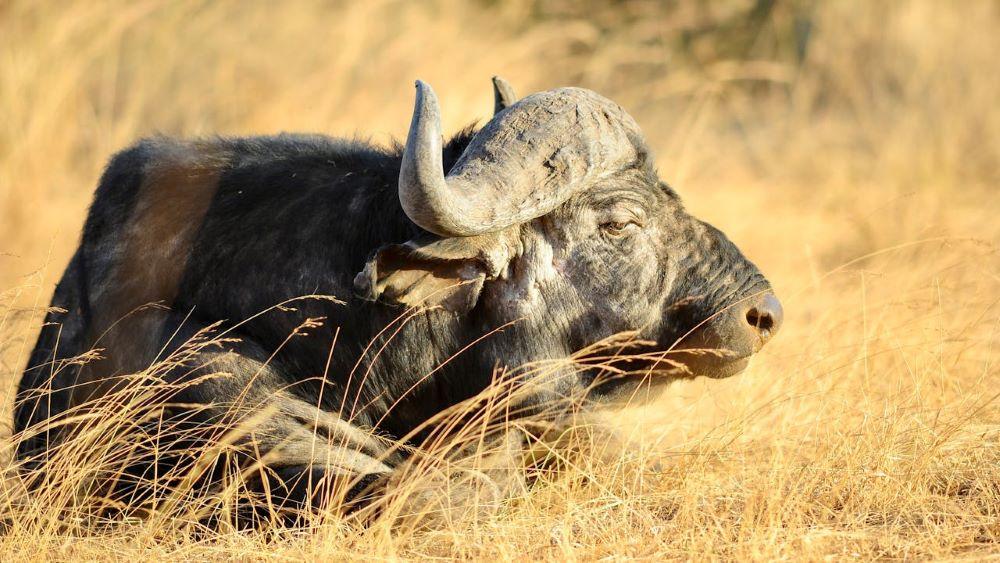Nicknamed “Africa’s Black Death” and “The Widow Maker” the African buffalo is an aggressive, dangerous, and highly sought-after member of Africa’s Big 5 and Dangerous 7.
[DYNAMIC-BLOGTABLEOFCONTENT]
The African Buffalo
Africa is home to three main species of buffalo:
- Southern Savanna/Cape Buffalo (Syncerus caffer subsp. caffer).
- Central African Savanna Buffalo (S. c. aequinoctialis)
- West African Savanna Buffalo (S. c. brachyceros)
The buffalo is the only bovine species found among African big game. The one which is the most common on game hunting expeditions is the Cape buffalo. These Cape buffalo are originally found in the southern areas of Africa, where they live in various habitats and ecosystems. Cape buffalo are herd animals, with a herd being made up of breeding bulls, cows, and young Cape buffalo. Older bulls that have left the herd are done breeding, and these bulls generally form bachelor herds or live a solitary life.
A Cape buffalo is considered African big game, a reputation well-deserved as they are among the largest African herbivores. They possess a set of massive headgear. The horns begin at the base of the skull, connected to it with big round bases, commonly known as bosses. These bosses then grow out to the side of the skull and create a rounded horn that flares backward. Cape buffalo use these horns to fight off natural predators, such as lions and hyenas. Cape buffalo males will also use this impressive headgear to establish ranks and dominance amongst other bulls, where they determine the right to mate with females. An immature Cape buffalo bull will have underdeveloped bosses that feel soft to the touch, whereas mature and old males have hard bosses that protect their skulls and grow to impressive dimensions.
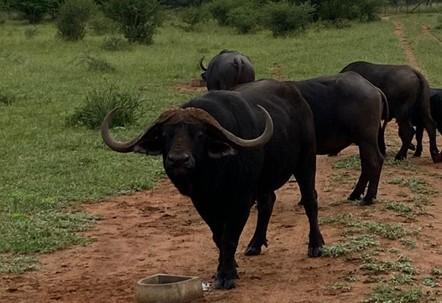
Cape Buffalo Breeding Operations In South Africa
Cape Buffalo hunting in South Africa is widely popular among international hunters for one specific reason; bigger is better. South Africa intensively breeds Cape buffalo on many game ranches across the country. These game ranches aim to breed Cape buffalo which have wider horns, bigger bosses, and heavier, more muscular bodies. These animals are bred for game hunting, conservation sustainability, and long-term breeding programs. Cape buffalo within these programs are selectively chosen according to specific characteristics, among both males and females. Bulls typically breed with large quantities of cows, generally between 40-60 cows for one bull.
The South African intensive breeding industry provides the game hunting industry with exceptional wildlife of all kinds of species, in this case specifically Cape buffalo as they are popular species for hunting in South Africa.
Cape Buffalo Breeding Bulls
These animals are often taken out of natural systems and chosen according to specific characteristics that are unique and will breed well. Breeders look for the following characteristics in a Cape buffalo breeding bull:
- In the sexual prime of their life – between six and eight years of age.
- No genetic abnormalities or defects.
- Horns of at least 45 inches in width – the biggest Cape buffalo currently breeding in one of these systems is 56 2/8 inches.
- Bosses with a width of at least 18 inches.
- A scrotum that is naturally shaped and with a circumference of at least 15 inches.
- Large physical stature and high volume of muscle mass.
- Fertility tests to confirm breeding ability.
- Blood tests – checking for diseases such as tuberculosis and corridor disease, only clean Cape buffalo will legally be allowed to breed.
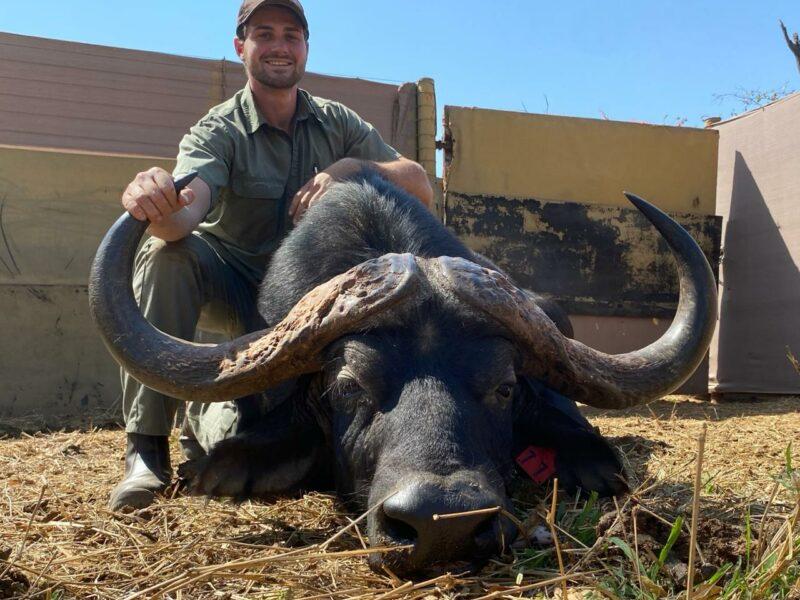
Cape Buffalo Breeding Cows
On the other hand, breeders are also required to be highly selective in choosing Cape buffalo cows, with many characteristics that are different and alike:
- In the sexual prime of their life – between three and eight years of age.
- No genetic abnormalities or defects.
- Horns of at least 28 inches in width. Buffalo cows have been known to exceed the width of 42 inches in rare cases.
- Bosses are not important – cows do not have distinguished bosses like bulls.
- A vulva, vaginal cavity, and uterine wall which is healthy and fit for carrying and birthing numerous calves.
- Mammary glands which are healthy and able to feed their calves with sufficient daily milk production.
- Large physical stature and high volume of muscle mass – specifically wide hips to allow a calf to grow and be birthed easily with no human assistance.
- Fertility tests to confirm breeding ability.
- Blood tests – checking for diseases such as tuberculosis and corridor disease, only clean cape buffalo will legally be allowed to breed.
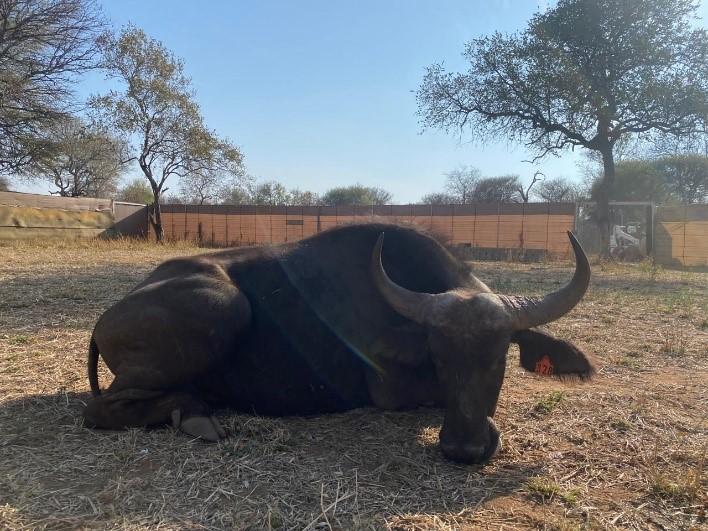
Cape Buffalo Breeding Breeding Camps
Once these Cape buffalo breeding individuals have been determined, they are placed in large camps, these camps can be any size from 120 acres to 250, 000 acres depending on the resources available. Herds are generally made up of roughly 50 cape buffalo cows and one singular bull to cover all the cows, allowing for no conflict between bulls. The fence enclosing these animals needs to meet certain industry standards:
- 8 feet in height.
- At least 21 strands of horizontal galvanized wires, connected by vertical steel poles.
- Anchor poles concreted into the ground at 330-foot intervals.
- Electric fencing adequate to contain the wildlife, powered with at least 4, 000 volts.
These standards ensure that the Cape buffalo do not escape their enclosure and that other Cape buffalo do not break into the enclosure to breed with any members of the herd. These fences also help keep out predators such as lions, spotted hyenas, and black-backed jackals who will prey on any weak or small calves.
The Sale of Cape Buffalo in South Africa
Cape buffalo are among the most expensive wildlife for sale in South Africa, and prices rise even more so according to the size of the horns, breeding ability, bloodline, and origin, and this applies to both male and female specimens.
These animals are generally sold at wildlife auctions, where animals are tranquilized and moved to these facilities to be viewed and purchased, or they may appear on a catalog and be relocated later. Their capture can be dangerous and is not for the faint of heart! Cape buffalo are not fully sedated when being handled and are merely more docile and calmer. Experienced capture teams and wildlife veterinarians fulfill these tasks.
Once captured, they are placed into holding facilities with other Cape buffalo, as they are herd animals that need to be kept together to prevent stress, which can be fatal. They are provided with food and water daily, and only kept in these conditions temporarily. The sale of intensively bred Cape buffalo is a massive aspect of the wildlife breeding industry in South Africa, with a record price being reached, In 2016 when a 52-inch cape buffalo bull was sold for ZAR168, 000, 000 (approximately 8, 800 000USD).
Where Is The Best Place To Hunt Cape Buffalo in Africa?
Buffalo hunting in South Africa is a dream for many hunters across the globe. The Cape buffalo is a trademark African species and dangerous game hunting.
South Africa proves to be a popular destination for Cape buffalo safari hunting for a variety of reasons:
- Genetically superior Cape buffalo in terms of horn and body size.
- Numerous terrains, habitats, and different hunting areas from which to choose.
- Well-established Outfitters and Professional Hunters who have experience in Cape buffalo hunting and African hunts as a whole.
- Many other African safari hunting species to choose from as a filler hunt or additional hunting experience.
Aside from South Africa, there are many other options available for African buffalo safari hunting. Tanzania is one of the leading countries for African buffalo hunts, producing wild free-range buffalo which breed in open systems of government-owned concessions. This country provides a free-range hunting experience in natural open systems, many hunters prefer these conditions for their African hunts. Other countries that also provide similar open systems and free-range African big game hunting are Mozambique, Zambia, Zimbabwe, Namibia, and Botswana.
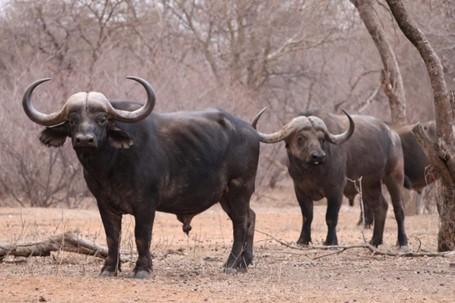
What Is The Best Caliber For African Buffalo Hunts?
There is no specific caliber that proves to be the best for African buffalo hunts. A .375 and larger is recommended and is enforced by law in many countries, specifically for big game hunting in South Africa. A caliber of this standard and size must be used on all dangerous game hunts to ensure a safe hunting environment and reduce the likelihood of a dangerous situation, such as a wounded Cape buffalo. This is, however, not always the case, as Cape buffalo are renowned for soaking up bullets like a sponge!
The Cape buffalo also kills the most people every year on safari hunting trips. A hunter should choose a caliber of rifle that they are comfortable shooting and can shoot accurately.
There are however a few favorite calibers that are used among hunters:
- .375 Holland & Holland
- .416 Rigby
- .458 Winchester Magnum
- .458 Lott
- 500 Niro Express
All the above calibers are a good choice for African buffalo hunts, but what is important is the hunter’s ability to shoot the Cape buffalo accurately in a practical situation while keeping correct shot placement in mind.
Why are Cape Buffalo so Aggressive?
African big game in general are known to be aggressive and dangerous in a game hunting situation. The Cape buffalo is thought to be the most aggressive above all, and in many cases do indeed live up to their reputation in this regard. They have an instinct for confrontation and aggression as a defense mechanism, for when they are being hunted by natural predators such as lions and hyenas they often turn and fight to survive.
It is simply in their natural behavior to do such. This aggression can often be acted on with little reason, as a Cape buffalo may charge for what seems to be no apparent reason. The real reason is that the Cape buffalo feels threatened, and in many cases, they do flee the scene as an effort of defense, but charges often occur. This makes them unpredictable and one of the most dangerous African hunts. The likelihood of a Cape buffalo charging and acting aggressively increases in environments where they are regularly hunted, as they learn quickly that they are in danger and live up to their reputation and confront said dangers.
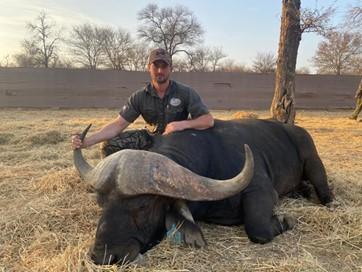
Cape buffalo bulls are significantly more aggressive than Cape buffalo cows, this can be due to a higher level of testosterone found in males. Older bulls, also known as Dugga boys, are past their breeding days and live out the rest of their lives living in small bachelor herds. These bulls have less competition when feeding and are allowed to grow to their maximum physical potential under the right circumstances with nutrient-rich vegetation to feed on.
During African hunts in the pursuit of Cape buffalo, these Dugga boys are the animals that are generally targeted for numerous reasons:
- They are mature bulls.
- They have completed their breeding and reproduction stage of life.
- They make excellent trophies with impressive headgear – the perfect safari hunting specimen.
- They feed heavily on the vegetation, removing them from the system allows for the recovery of the vegetation to occur.
- They are often problem animals, being potential dangers to other animals and people living in the area.
How Many African Buffalo Are Left In The World?
The African buffalo is not in any immediate threat or danger of being extinct and having their species wiped out. The African buffalo is listed as least concern by the International Union for Conservation of Nature (IUCN). The species remains widespread across the African continent, finding a home in its historical natural habitats, as well as being introduced into newer areas where they do not naturally occur.
A global population estimate states there are approximately 900, 000 buffalo not just in Africa, but worldwide. This includes educational centers such as zoos in foreign countries, as well as exotic game ranches and wildlife sanctuaries. More than three-quarters of this global population is found in protected areas, meaning that designated conservation efforts are in place to conserve, preserve, and protect these wildlife populations. This population is relatively stable but is still gradually decreasing due to habitat loss and habitat fragmentation.
Read more about Cape buffalo in this recent blog entitled “Cape Buffalo Hunting in Zimbabwe: Are You Ready?”
Author: Keenan van Wyk (Conservationist & Professional Hunter)
